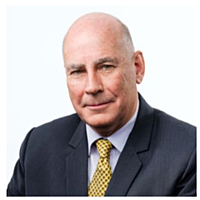Central Bankers are not your friends
In 2014, the former head of the US Federal Reserve, Ben Bernanke, stated “the problem with quantitative easing (QE) is that it works in practice but it doesn’t work in theory”.
The simplicity of that statement made by the architect of the US monetary policy response during the heights of the Global Financial Crisis (GFC) in 2008, underlines the problem that confronts analysis regarding the outlook for the world economy and investment markets in 2021. The predicament is made no easier as the COVID19 crisis is managed by vaccines whose long term efficacy is still based on theory rather than practice!
Based both on Bernanke’s comments, and observing the meandering of monetary policy across the world, it is arguable that no central banker, no policy maker, no regulator, nor any Government advisor, truly knows what the long term consequences of these/their historic policies will ultimately be. It is notable that the political leaders of the free world rarely (if ever) use the word “QE” in discourses with their citizens. Remarkably, that is the case even though it is the essential plank of their economic policy settings. Compared to their discourses on policy regarding COVID19 and the need for vaccination rates to rise, the difference in terms of transparency is stark.
Certain monetary policy settings have become oppressive for many citizens of the western world. Two in particular stand out.
First, the maintenance of “negative” real interest rates degrades the value or purchasing power of average people’s savings as they are eroded by inflation. This policy is rarely acknowledged or justified by central bankers.
Second, monetary policy is stoking asset price inflation, most notably in housing prices, which simply make the quest to own a home for young families (today or tomorrow) unattainable without access to more cheap debt.
It is my view that central bankers are rarely proactive, and they tend to be aggressively reactive. They are seemingly sanguine as to the long term repercussions of their policies.
For instance, in Australia, the utilisation of QE was belatedly adopted in 2020 when it was undertaken in response to the onset of the pandemic. Up to that point, the RBA had stated that it saw no need for QE, even as all major overseas central banks had already adopted QE (and done so for many years).
In Japan, it had been adopted for twenty years to deal with rolling deflation and the management of their growing government debt. In both the US and Eurozone economies, QE was implemented and sustained as a response to the meltdown in financial markets, and the ongoing risk to financial institutions flowing from the GFC.
Today, QE is undertaken by central banks right across the western world (including aggressively in New Zealand) and has been instigated in India. It seems sensible to suggest that QE will be rolled out in some form in China, as authorities grapple with the restructuring of the property giant Evergrande.
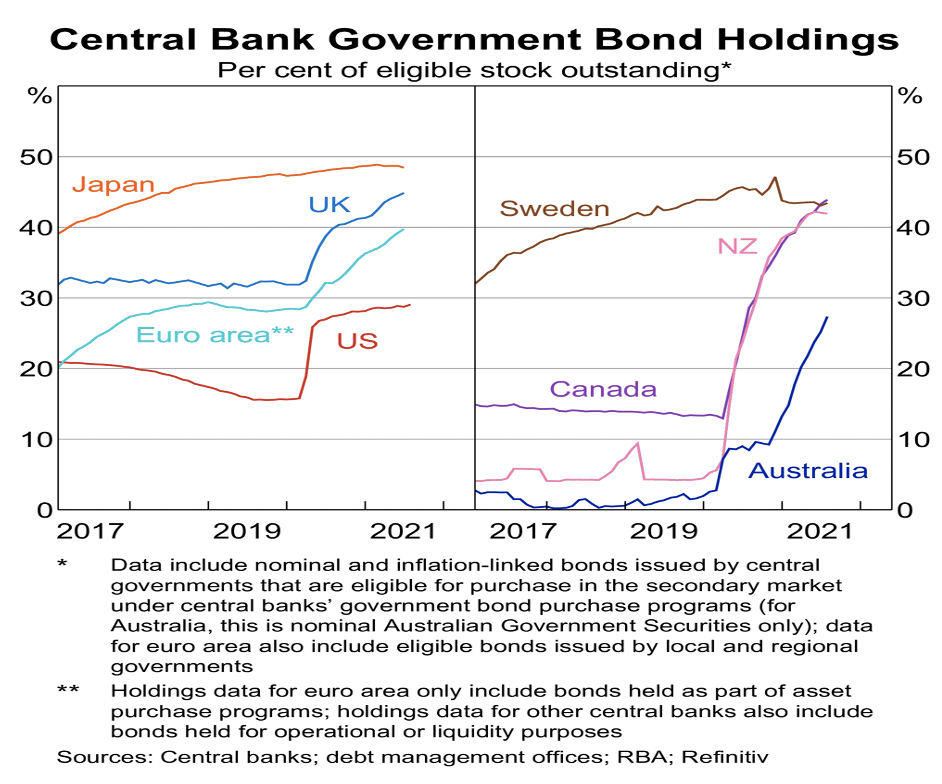
Whilst these observations may be regarded as confronting, they should not excessively concern you (as an investor) for two reasons.
First, you are aware that we are passing through a speculative era supported by massively manipulative central bank policies. Knowledge is powerful and in this case, it allows you to understand the effects on asset prices that central bankers are causing.
Second, in acknowledging the first point, you are therefore aware that the world economy is traversing a dramatically new, indeed unique period in history, leading to an investment era that requires a different thought process to design a portfolio across asset classes. I will come back to this aspect later.
Today, the result of aggressive QE is that investment markets, more than normal, are pricing assets with speculative fervour. Whilst speculation is not new, today it is in abundance. In that context, it is worth remembering that whilst speculation can sometimes be wrong, that is not always the case. Therefore, and in spite of the rampant speculation, we should not (and indeed cannot) stop investing. Rather we should acknowledge the environment, the cycle and adapt our investing practices, for this period will endure for many more years.
As Ben Bernanke stated in 2014, “QE works in practice” and therefore we can conclude that it will be maintained as a policy until it doesn’t work. Of course, that begs the questions as to what working means? And for whom is it working?
The inflation illusion or confusion
The claim of most central bankers is that they will maintain QE policies (and therefore not taper them) until inflation is sustainably in a band above or around 2%. They proclaim that zero interest rates or negative real interest rates are desirable until we see inflation. That of course creates the impression that there has not been inflation in recent years.
The following chart tracks inflation readings of advanced countries (US, Japan and Euro area) and challenges the suggestion that inflation is occurring at a level that justifies zero bound interest rates.
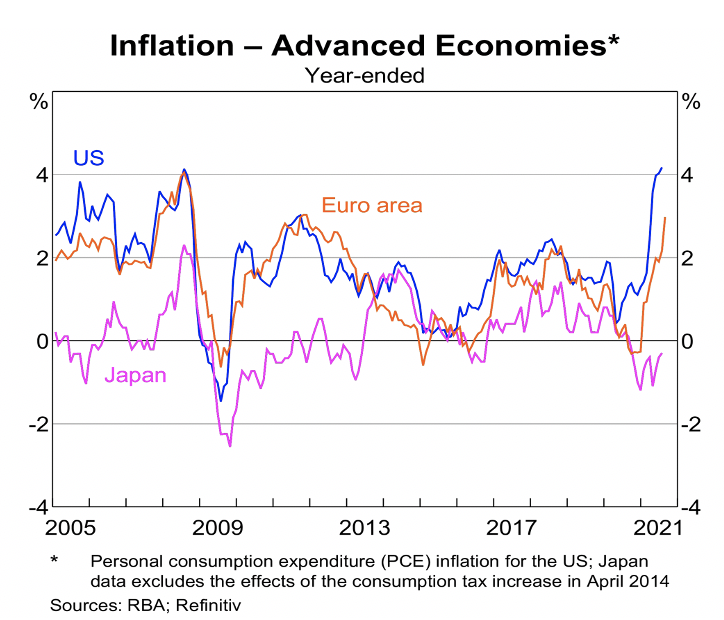
Whilst recent inflation readings are elevated (in Europe and US) by pandemic supply-line disruptions, lockdowns and base effects, it is interesting to observe that German ten year bond yields have been below 0.5% in yield for the last 6 years. Over that period, European inflation has averaged over 1% per annum. As COVID19 erupted, European inflation plummeted before accelerating as economies recovered. Meanwhile, the German bund (a proxy for euro bonds) has barely reacted under the weight of European Central Bank QE policy.
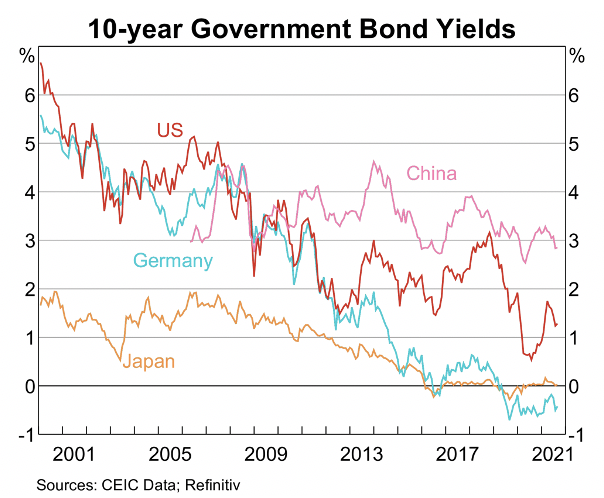
At the short end of the interest rate spectrum, we can see that “cash rates” across the world have converged at around zero yield. The aggressive response of the US Federal Reserve to the pandemic is clear to see (as it was in Australia), but in Europe and Japan cash rates have been negative for the last seven years whilst inflation has been positive.
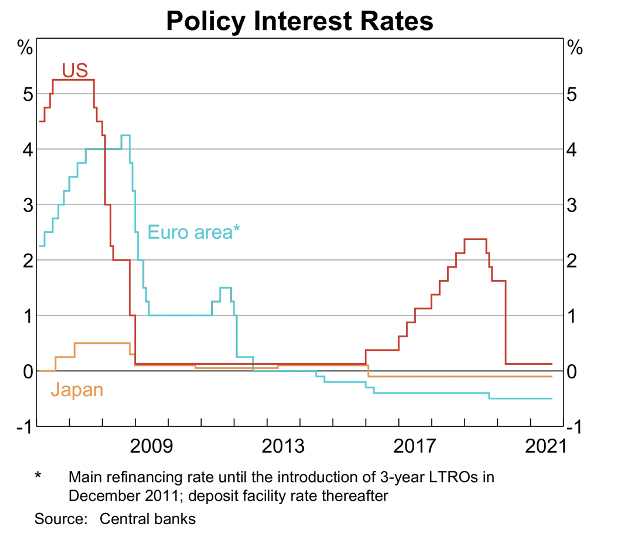
It is therefore clear that the nexus between inflation, cash rates and bond yields has been broken. That is a deliberate policy direction of the world’s central bankers. There is no certainty that the onset of elevated inflation will result in a “material” adjustment to either bond yields or cash rates.
There is no certainty that sustained inflation readings of above 2% (say) will result in cash rates rising to 2%, and therefore protect passive savings.
Indeed, the likelihood is that the central banks will gradually adjust rates as an acknowledgement of the debt and asset bubbles that they have created. They cannot burst the bubbles that they have created, and the biggest bubble is in developed world bond markets. Letting the air out of a balloon slowly is a tricky business.
Therefore we predict that QE in the US will be maintained for some extended time. This view is informed by the following chart which tracks the level of US Government debt to GDP. Talk of QE tapering (i.e. reducing bond purchases) does not make sense given Ben Bernanke’s observation that “QE works in practice”. Let’s be clear – QE helps the US government service its massive debt and it is working. Therefore while we should note that the market is full of “central bank speak” suggesting that tapering is maybe desirable or necessary, we should treat it with appropriate cynicism. If tapering causes bond yields to rise and creates a dislocation in bond markets, then why would they do it?
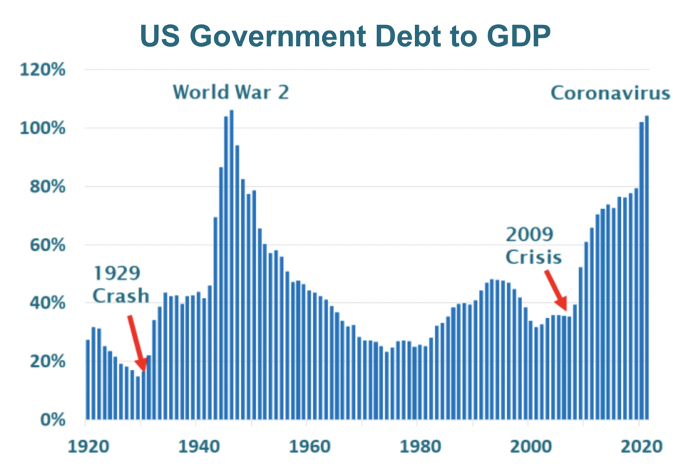
As US government debt has dramatically risen, so has the size of the balance sheet of the US Federal Reserve. Noted below is the US$4 trillion rise in the Federal Reserve balance sheet since the onset of COVID19. This corresponds to about 20% of US GDP, and matches the rise in US government debt. The Federal Reserve has therefore been funding the US Government and maintaining very low bond yields and thus low interest costs. Given the success of this strategy then why would they stop? Alternatively, can they stop? The Japanese experience suggests that QE is here to stay – at least till it doesn’t work.
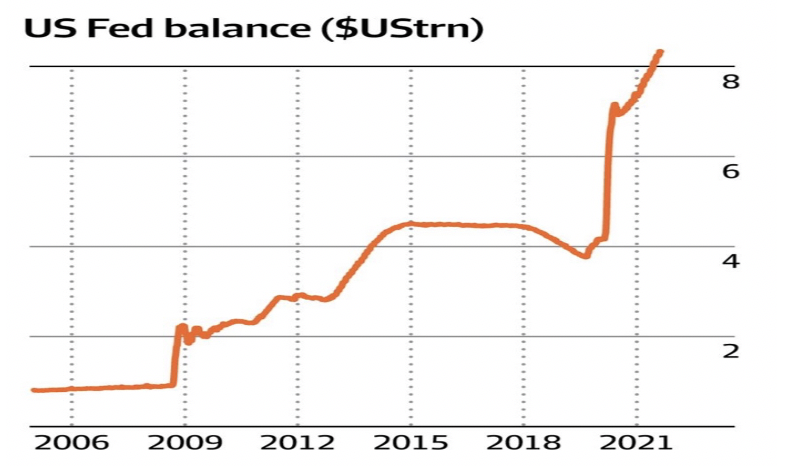
Source: The US Fed
This analysis does not imply that QE, zero bound cash settings and massive fiscal support was not required in response to the COVID19 crisis. It clearly was, and is still required as lockdowns re-occur and new COVID19 waves are dealt with. The developed world (shown below) has still not recovered its pre-pandemic GDP levels, and Australia (in particular) is suffering a slip in GDP that will pull it back below pre-pandemic levels.
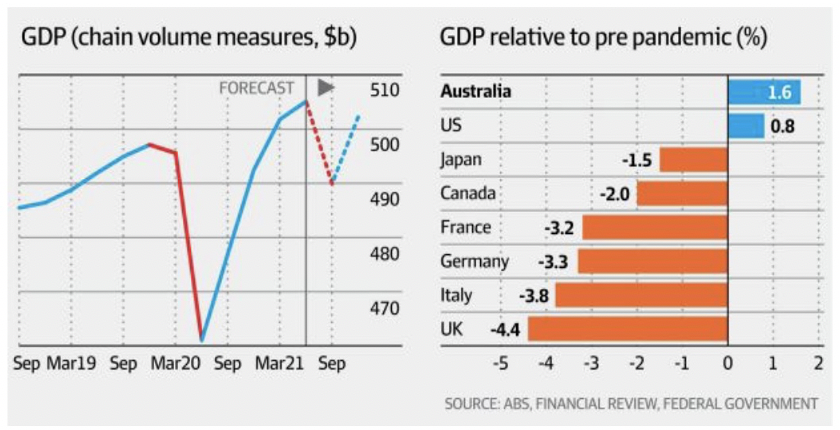
Our analysis challenges the view that the road back to the “normal” of the past will be simple, and that tapering or the suspension of QE is easy. Whilst the reduction of bond purchasing by central banks across the world will be attempted, albeit tentatively, there is no reason to expect that it will be undertaken aggressively.
Therefore, in Australia, as the RBA has reaffirmed on multiple occasions, there is no reason to expect that our interest rates to rise any time soon, no matter what inflation does.
Investment and Portfolio considerations
Investment markets are nearly always confronted by myriad headwinds and/or supported by tailwinds. The job of an investor is to gauge these forces, consider their implications, and invest more heavily on winning strategies and lose less on unsuccessful ones. Markets tend to overshoot in both directions: will the headwinds be greater than the tailwinds or vice versa?
Ever since the commencement of the pandemic in early 2020, the tailwinds created by zero bound interest rates, negative real interest rates, fiscal largesse and QE have been both strong and persistent. They exist today and they will continue for the foreseeable future – at least for the next 2-3 years. The central bankers of the world, no more so than in Australia, are telling us that.
The headwinds come and go, but occasionally blow hard. Right now, the issues surrounding Chinese trade and property debt issues, rolling COVID19 outbreaks and lockdowns, and the looming US debt ceiling (yes, we are back there again) are intermittently blowing with some intensity.
Our observation is that the tailwinds of low interest rates (in particular) have been well factored into equity market valuations, and therefore the current effect of any earnings downgrades, particularly caused by lockdowns and China trade, have become more persuasive.
Whilst we maintain our strong belief that Australia retains its solid long term growth profile, one that is superior to many of our developed economy peers, we acknowledge that COVID19 lockdowns will lead to earnings downgrades for some domestic businesses.
Overall, we maintain our balanced weighting of assets across listed income, unlisted credit (when available), direct property (focused on industrial, agriculture and non-discretionary retail) and high quality equity businesses both domestic and overseas.
The risk created by low interest rates is best managed by having a strongly diversified portfolio across multiple asset classes.
Low yielding and so-called “low risk” debt or bonds do not offer an adequate return, and any returns from these assets will be consumed by inflation.
While there are still outstanding investment opportunities available, in general equities remain a hold, and any pullback should be used as an opportunity to add to a quality and value-focused portfolio. Companies that generate sustainable growing cash flows and high returns on equity should be favoured.
Due to the COVID19 outbreaks and the noises emanating from China, we expect that balanced returns will be around 6-7% in FY22, with upside potential to equity markets emanating from a clear resolution to COVID19 outbreaks.
In determining whether a balanced return of 6-7% is adequate or acceptable, investors should remember that the risk free interest rates are effectively zero based, the Australian economy is traversing a downturn, and inflation is anchored around 2%.
Of course, the usual disclaimers apply: readers of this Letter should note that the best course of action will be to obtain professional advice tailored to their own particular circumstances, and that forecasts of returns over financial year 2022 are based on our base case scenario – and if we have learned anything in the last two years, unexpected things will happen.
Why you can't miss Livewire’s Income Series
Click here to view the dedicated website, which includes:
- The list of top performing, income focused ETFs, LICs and funds.
- Detailed fund profile pages, with data powered by Morningstar.
- Exclusive interviews with leading fund managers.
- Videos and articles to help you perfect your income strategy
4 topics
